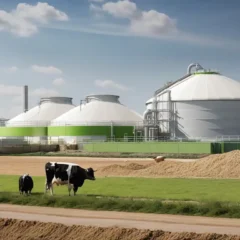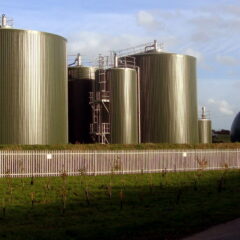How to Reduce Methane Emissions from Cattle: A Comprehensive Guide for Farmers, Scientists, and Environmental Activists
Mooove Over Methane: How to Reduce Methane Emissions from Cattles – sustainable Solutions for a Greener Future Livestock, particularly cattle, play a vital role in our global food system, providing meat, milk, and dairy products that nourish billions. However, enteric fermentation in the rumen, a specialized part of a cow’s digestive system, produces a significant […]
How to Calculate the Size of an Anaerobic Digester Tank
Hi! This is a bonus track on Anaerobic Digestion. What we’ll do is we’ll calculate the size of a fixed-dome reactor for the example of a boarding school. Okay. This is the situation. A boarding school with 250 students and about 50 staff in a tropical climate. We have around 0.2 kg of wet waste, […]
Costs of Anaerobic Digestion and the Functions of a Biogas Business
The cost of anaerobic digestion plants varies greatly depending on their size and the feedstocks they use. Small-scale farm-based plants that use manure and are supplemented with purpose-grown crops to produce modest amounts of biogas are relatively inexpensive. They can function well, but as they require constant attention can be time-consuming to operate. Large, commercial […]
Chicken Litter Anaerobic Digestion
Poultry litter is organic waste such as dung, spilt feed, feathers, and bedding materials produced by chickens and turkeys. This material is high in plant nutrients such as nitrogen, phosphorus, and potassium. However the total composition will vary depending on the species of fowl, the amount of feed utilised, and the collecting method. Poultry litter […]
The Benefits of Biogas to the US & How the 2018 Farm Bill Affects the AD Industry
On This Page The Benefits of Biogas Raw Biogas and Digestate Environmental and Energy Study Advanced Biogas Plant Design Biomass Inventory and Bioenergy Assessment AG Energy Coalition releases 2021 policy recommendations How the 2018 Farm Bill Affects the Biogas Industry The Benefits of Biogas and the Impact of the 2018 Farm Bill on the US […]
What is Anaerobic Digestion?
On This Page What is Anaerobic Digestion? Basic Information about Anaerobic Digestion (AD) What Are the Main Benefits of AD? Types of Anaerobic Digesters Waste and Wastewater Treatment Mature Technology Available Right Now Single Reactor or Multireactor Systems Bioenergy and Anaerobic Digestion All anaerobic digestion systems adhere to the same basic principles whether the feedstock is […]
The Anaerobic Digestion Process
The anaerobic digestion (AD) process works by bacteria, which thrive in the absence of oxygen, breaking down the bio-degradable fraction of the waste to generate a stable deposit. This consequently aids to reduce hazardous emissions of dangerous greenhouse gases. That’s true, as biodegradable material which is just sent to garbage dump will give off a […]
Anaerobic Digestion: The Most Important Renewable Energy Source You May Not Have Heard of
Anaerobic digestion (AD) may sound rather like an uncomfortable stomach complaint. However, for most people it’s sure to be the most important renewable energy source you not heard of. AD may hold associations with manure and unpleasant smells. But, whatever your impressions might be, it is an emerging technology with enormous “green” potential. It’s a […]
Technology – Drivers for change
Biogas tanks – Greenfinch Plant at Tenbury Wells Drivers for Change The EU Landfill Directive sets targets over the next 20 years for the reduction in the landfilling of biodegradable waste, which consists of putrescible kitchen waste, garden waste, paper, card, textiles and wood. EU Animal By-Products Legislation, came into force on 1st May 2003. This […]



